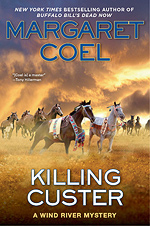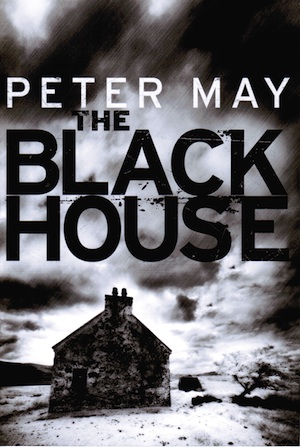Another in Margaret Coel's "Wind River Mysteries" series (this is #17), set in Wyoming on the Wind River Reservation, shared by Arapahoe and Shoshone tribes. The setting, St. Francis Mission, is based on the actual St. Stephens Mission that has been there since 1884. The mystery here centers around the murder of a George Custer re-enactor during a pre-rodeo season parade. The man has come to Indian Country to flaunt the massacre of Indians by Custer and so the logical assumption is that some of the Indians riding in the parade shot him. In fact, Detective Madden has managed to threaten enough people on the reservation to get a supposed eye witness account to support that version of events. Neither Father John O'Malley nor attorney Vickie Holden believe either of the accused young Arapahoe men are capable of murder, but they are going to have to find convincing proof otherwise if they want to save them from jail. When there is a break-in at the office of a well-known lawyer in Lander and he appears to be missing, Vickie begins to wonder if there is a connection between the two events. The Indian woman who was secretary, and lover, to the missing attorney is brought in for questioning, Vickie initially serves as her attorney, but she is aware the young woman is holding back key information from her and tells her to find an attorney she can trust and confide in. When the young woman is subsequently murdered, Vickie holds herself responsible. Further, Vickie has already been contacted by the widow of the murdered Custer impersonator to find his missing money, so Vickie is unable to represent either of the two Arapahoes accused. She finds herself on the wrong side of a line she struggles to straddle. Her goal is to defend Native Americans and here she is stuck defending a white woman and, due to conflict of interest, unable to defend her fellow Indians. Each pursuing their own leads, Vickie and Father John eventually join forces to track down the missing attorney and maybe tie him to the murders, if they don't get killed first. As always, solid writing with lots of interesting history thrown in for good measure. Well constructed plot and loving portrayal of the setting. See my two earlier blogs on The Girl With Braided Hair, and Eagle Catcher by this same author.
Keeping track of what I read by jotting down my reactions, providing information about the author, and linking to additional reviews. And occasional notes on other book related things...
Saturday, September 30, 2017
Saturday, September 2, 2017
Y is for Yesterday
Sue Grafton has taken the somewhat unusual road of setting all of her Kinsey Milhone novels in a short time period in the 1980's, and aging her protagonist only a few years, from 32 in A is for Alibi to 39 in this latest installment (what will happen when she reaches "Z" all her fans are wondering?!--maybe I will go back and start reading from the beginning ;-). The present stories start in the fall of 1989 but one of the threads is tied to events from the spring and summer of 1979, when a teenager, Sloan Stevens, was murdered by a classmate from a fancy private academy. Fritz McCabe, the one who actually pulled the trigger, has now been released from prison since he was convicted as a minor and has to be released on his 25th birthday. His parents have received a $25,000 blackmail demand in relation to a video tape Fritz and his buddies made in high school showing the sexual assault of a very drunk 14 year old classmate by Fritz and another boy, Troy. If the tape were sent to the DA, Fritz would go back to prison for statutory rape, for which there is no statute of limitations. The parents don't want to pay, and are advised not to pay by their attorney, who refers them to Kinsey. Kinsey delves into the past events surrounding the making of the tape, and the cheating scandal at Climping Academy that started the ball rolling and eventually resulted in Sloan's death. Fritz was just a pawn, and the emotional bully who ran the show back then, Austin Brown, disappeared before Fritz confessed and hasn't been seen in 10 years.
Meanwhile, the man who tried to kill Kinsey in the previous book, X, has returned; he is looking for the "souvenirs" he took from the series of young girls he murdered. He thinks either Kinsey or one of his ex-wives might have them, and he will do anything to get them back, including taking a second run at killing Kinsey--for good this time. Meanwhile, the usual cast of characters, Henry, Rosie, Cheney, and Anna are all around and dealing with their own personal dramas. As always, Kinsey's character is feisty and engaging, and the thinly veiled town of Santa Theresa (Montecito) is always fun to visit. The ending was a surprise to me, but then I am obligingly misled.
Meanwhile, the man who tried to kill Kinsey in the previous book, X, has returned; he is looking for the "souvenirs" he took from the series of young girls he murdered. He thinks either Kinsey or one of his ex-wives might have them, and he will do anything to get them back, including taking a second run at killing Kinsey--for good this time. Meanwhile, the usual cast of characters, Henry, Rosie, Cheney, and Anna are all around and dealing with their own personal dramas. As always, Kinsey's character is feisty and engaging, and the thinly veiled town of Santa Theresa (Montecito) is always fun to visit. The ending was a surprise to me, but then I am obligingly misled.
The Blackhouse
This novel by prolific and award-winning author Peter May is the first of the "Lewis Trilogy," a series of murder mysteries set on the Isle of Lewis in the Outer Hebrides of Scotland. The landscape is harsh and the living is hard on these islands and kids growing up there often cannot wait to get away. This was certainly true for Fin McLeod, who had extra incentive because his parents had died when he was young and he was raised by an aunt who had little time for him and expressed no sympathy or affection for the bereaved child. Still he had his friends, and a girl who liked him from the first grade, so it seemed not all bad. Until the eve of his departure for university, when his friend's father and Fin's tutor for college prep told Fin and Artair (his son and Fin's best friend) that the boys had been chosen to join the guga hunt--a right of passage that involves sailing across 50 miles of empty ocean to an island where seabirds nest and then killing and bringing back hundreds of the young birds as a delicacy for the islanders. It is an event decades old in tradition, held onto all the more firmly in the face of animal rights protesters. For Fin and Artair, it will be a turning point in their relationship and their lives.
Fin does indeed go off to university in Glasgow but can't engage and eventually becomes a detective with the Edinburgh CID. When a grisly murder is committed on the Isle of Lewis, identical in many details to one recently investigated in Edinburgh, Fin is the obvious choice--even though he has recently lost his only child. His return launches a story told alternately in the past and the present, with Fin's history being revealed a piece at a time while he continually confronts painful reunions in the present. This is a dark book and I wonder if living so far north, like the Scandinavians and the Scots do, focuses people on the darker corners of human nature. The ending of this book came as a total surprise to me. Don't read this book if you are looking for a happy ending. Do read it if you like noir detective stories.
Interestingly, this book was bought up by a French publisher after being turned down by numerous British publishers. Subsequently, it was bought by numerous publishers and has been translated into several languages. Glowing reviews from The New York Times, The Scotsman, the NY Journal of Books, and Publishers Weekly. It was also named one of Kirkus' "10 Best Crime Novels" for 2012. More info on Peter May at Wikipedia.
Fin does indeed go off to university in Glasgow but can't engage and eventually becomes a detective with the Edinburgh CID. When a grisly murder is committed on the Isle of Lewis, identical in many details to one recently investigated in Edinburgh, Fin is the obvious choice--even though he has recently lost his only child. His return launches a story told alternately in the past and the present, with Fin's history being revealed a piece at a time while he continually confronts painful reunions in the present. This is a dark book and I wonder if living so far north, like the Scandinavians and the Scots do, focuses people on the darker corners of human nature. The ending of this book came as a total surprise to me. Don't read this book if you are looking for a happy ending. Do read it if you like noir detective stories.
Interestingly, this book was bought up by a French publisher after being turned down by numerous British publishers. Subsequently, it was bought by numerous publishers and has been translated into several languages. Glowing reviews from The New York Times, The Scotsman, the NY Journal of Books, and Publishers Weekly. It was also named one of Kirkus' "10 Best Crime Novels" for 2012. More info on Peter May at Wikipedia.
Subscribe to:
Posts (Atom)


